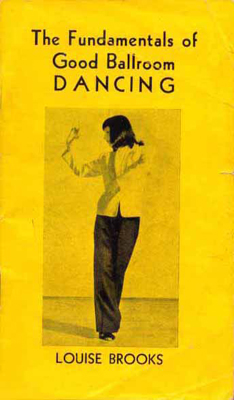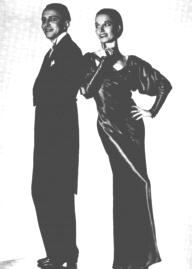Il Sunday Mirror (cfr.
infra), dopo aver debitamente ricordato Eddie Sutherland e Charlie Chaplin,
la apostrofò come "rather weary - looking singer", il che, per
una diva ufficialmente stroncata dal sonoro era perlomeno curioso: ammesso
che la notizia fosse fondata, una Louise cantante rappresenta un apax
artistico.
La coppia si mosse
con successo: un mese al Blossom Heath Inn di Detroit, un mese al già
citato Chez Paree di Chicago, quindi dal 10 Ottobre 1934 al 5 Dicembre
1935 al Place Pigalle, con notevole successo (cfr. infra le recensioni).
Dopo un tour che
toccò la Florida, l'Indiana e il Kentucky, Louise & Dario ritornarono
a New York al Central Park Casino, quindi al Capitol Theatre, di nuovo al
Place Pigalle per finire al Plaza, da Giugno ad Agosto.
Tuttavia, per
insondabili motivi, nuovamente si originò una rottura. Louise si
incamminò verso un ventennale inferno.
D'altra parte
"Dario si riunì con Diane e insieme danzarono verso l'oblio". |
|
Louise &
Dario e oltre: sei critiche
Anonimo,
"Sunday Mirror" (NY), June 30?, 1934 [Al Westchester Center Gardens]
"'Here today; gone tomorrow' and 'fame is fleeting' are old but true
expression, as witness - out in Westchester Country Center there is
appearing in the floor show a tall, sophisticated, rather weary -
looking singer named Louise Brooks. The majority of patrons who look and
listen every night never heard of her. She's just another night club
warber. Yet only a few years ago Louise Brooks was a star in the silent
films who once enthralled Charlie Chaplin and married Eddie Sutherland,
popular film director" Anonimo,
October 11?, 1934 [Al Place
Pigalle]
"The star of Louise Brooks' fortune, after suffering a score of ups and
downs, again is in the ascendancy. In less than six months after teaming
with Dario she has again become the toast of Broadway" O.
O. McIntyre, "American" (NY), October 11?, 1934 [Al
Place Pigalle]
"Louise Brooks and Dario threaten to recapture the furore of the Castles
... Miss Brooks is also of the socially elect"
Lipstick
(Lois Long), "The New Yorker", November 24, 1934 [Al Place
Pigalle]
"Another visit to the Place Pigalle after the theater got me up to Here
with ermine capes, smart chit - chat and Names ... Dario and Louise
Brooks are dancing. I didn't dare look at first, because Brooks is
always been a swell girl; when I finally peeked, I was grateful to
her for being a swell dancer besides. It is damn nice of her to be so
good"
Land., "Variety",
April 17, 1935 [Al Capitol Theatre]
"One of the dance acts is Louise Brooks and Dario from the Place Pigalle.
Did okay. Miss Brooks is an ex - star of films, but that fact is
unmentioned. Her radical change of coiffure makes identification not too
easy ... Dario handles her smartly and she handles herself with
commendable facility. White satin does not appear to be the ideal
selection for her"
Jimmie Fidler,
Movieland: it's people and products, "Appleton Post-Cresent",
November 21, 1940
"Louise Brooks, ex-star, is
teaching the rhumba and La Conga in Wichita, Kan."
|
|
Louise a Wichita
1939. Esiliata da Hollywood, fallito lo studio di danza di Beverly Hills
aperto assieme a Barry O'Shea (coinvolta per di più in una truffa dal
pregiudicato Crandall Fletcher), Louise Brooks unì le estremità di un
cerchio durato diciotto anni. Dopo un saggio consiglio del primo amante e
pigmalione Walter Wanger ("se rimani ancora qui per un
po'diventerai una squillo"), Louise Brooks decise di tornare nel
natio Kansas, a Wichita, "another kind of hell". Stavolta
non vi fu nessuna annotazione lirica nel suo diario. Era una resa. Era il
30 Luglio 1940.
Qui Louise tenterà
nuovamente di aprire una scuola di ballo, stavolta assieme ad Hal McCoy.
La coppia, che esordì il 22 Settembre 1940, dava esibizioni di rumba,
tango, foxtrot quale pubblicità per il proprio studio.
L'avventura durò circa un anno, ma la assoluta mancanza di diplomazia di
Louise nei confronti dei potenziali clienti e le frizioni con il compagno
fecero naufragare anche questa impresa. Fu lo stesso McCoy (che stava per
sposarsi e che la giudicherà incline ad una "vicious disposition")
a raccontare la rottura, come di consueto, definitiva e senza appello:
"... She was chewing my ass out about being a lousy dancer
... We were in the
cab - I didn't even have a car then. The cab stopped in front of her place,
and she said: "Well, are you going to come in?". And I
said: "No, I'm not coming in, and I doubt if I'm coming back".
She probably hadn't been rejected too many times. She got out of the car
and the taxi took me home, and that's the last time I ever saw her" |
|
The fundamentals
of good ballroom dancing
Il soggiorno nel Kansas produsse tuttavia la sua prima opera di una certa
consistenza, The fundamentals of good ballroom dancing (cfr.
infra), scritta sotto la supervisione del fratello preferito,
Theodore. Questo il piano del manualetto:
WHY DANCE? - What
good dancing means to you
BEFORE YOU DANCE - Essentials
that will improve your dancing
DANCING POSITIONS - Positions
taken in various dances
MOVEMENT AND DIRECTION - "Navigation"
on the dance floor"
GOOD DANCING - Why dancing is a
matter of discrimination and common sense
FOLLOWING - Five hints on how
to follow any man
BASIC RULES OF ALL DANCING - The
Four musts of good ballroom dancing
LEADING - How to be sure of
yourself
FOX-TROT - The simplicity of
our most popular dance
WALTZ - The key to beautiful
dancing
TANGO - A lovely dance made
easy
PRACTICE - How practice in your
home will improve your dancing
THE BASIC STEP - The secret of
good dancing and easy coordination
RUMBA - The original Cuban
dance explained
DANCE FLOOR ETIQUETTE - An
outline and review of good manners
RECOMMENDED RECORDS - The music
to look for when buying records for dancing
Riportiamo per intero il capitoletto iniziale, che funge anche da
introduzione: |
|
Why dance?
Dancing is as old as
history. People of antiquity would have answered the question as we shall,
for the instinct to "cut a rug" and synchronize bodily action
with the rhythm of music has been common to all ages.
Ballroom dancing's
foremost contribution is a social one. It is virtually the only recreation
in which social and physical recreation are combined with music to provide
an ideal socializing medium. The holiday dance, the club dance and the
formal balls are more than events where we undertake certain mechanical
movements in unison; they are occasions when we meet the people we know
and want to know, and join with them in the keen appreciation of a
stimulating activity - that is, if we know how!
Dancing is fun. As
we are elated and made to feel superblycompetent by an excellent game of
golf and tennis, so does the ability to dance with smooth, powerful, grace
gives us confidence and pleasure as well as the admiration of others. When
the band strikes up, get up! It's easier than tapping your foot, and much
less embarassing.
Dancing is the
front line enemy of overweight and age. The Correct dancing step will not
tolerate excess weight; hips and legs simply vanish when the muscles are
toned and tempered by this exercise. And unlike tiresome callesthenics, it
is fun. You have your cake and eat it, look younger, feel younger and are
younger!
The physical grace
that results from the perfect musical coordination that correct dancing
provides is a charm much rarer and more desiderable than superficial
beauty. In the last analysis, dancing beautifully depends
upon nothing more involved than
the ability to stand, walk and move beautifully. Complete physical
assurance and its consequent mental freedom, go hand in hand, and together
they unite to produce the truly beautiful, charming woman and the man of
distinction.
Ward McAllister,
the one time social arbiter of New York society, who wrote that the
members of his famous Four Hundred were those who possessed the ability to
be at ease in the ballroom, once said that not more than ten of his 400
could gracefully cross a ballroom floor alone. There is no record, but it
is safe to say that those ten could also enter a drawing room, or dance,
just as gracefully.
|

|
|
Sopra, la
copertina del libro di Louise Brooks, di 36 pagine, stampato in 750 copie a Wichita nel
1940, al prezzo di 50 centesimi. Stampato a spese della stessa Brooks, ne sopravvivono meno di 200 copie.
Potete godere della reliquia cliccando
qui |
A last and
important answer to our question, "Why dance?" can be stated
quite simply - you have to. Even though you are something of a hermit,
sometime, somewhere, you will be called upon and expected to give a
creditable showing. And that may be the one moment in your life when
there is nothing you desire more than the favorable opinion of a person,
or persons, whose respect and admiration you value.
For young men and
women, good dancing is of course indispensible. The never ending
succession of dances and balls may seem trivial to thoughtless parents,
but they are vital to these young men and women, whose success or failure
in making their early contacts may influence their entire lives. As Emily
Post says, "The great ballroom success, first and formost dances
well. All things being more or less equal, the girl who dances best has
the most partners. Let a daughter of Venus or an heiress of Midas dance
badly, and she might better stay home", and the same statement
could apply to young men. How cruel, and yet when we consider how little
effort, attention and study of the correct fundamentals is required, we
can only say that there is always a reason for poor dancing, but never an
excuse.
|

